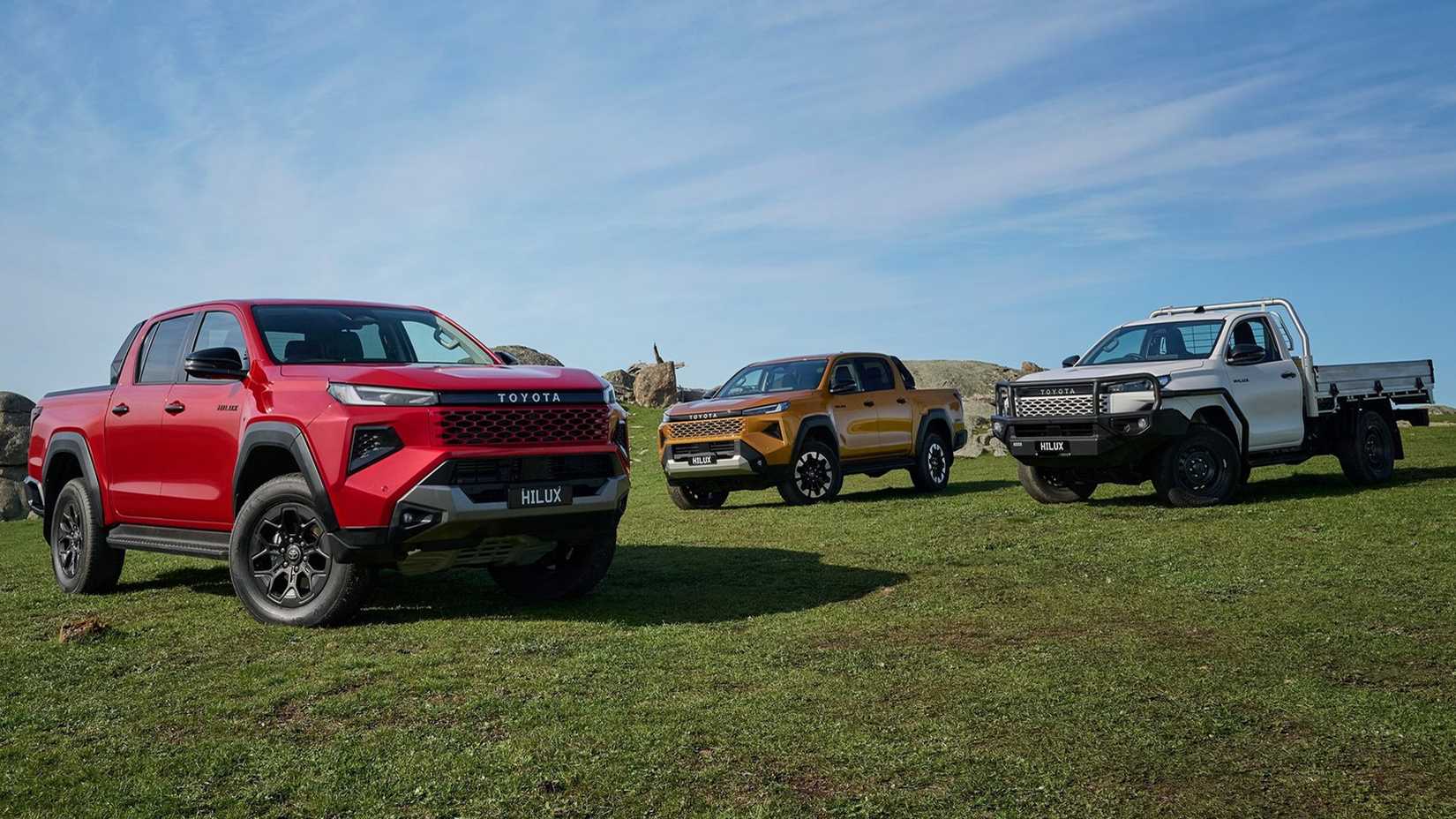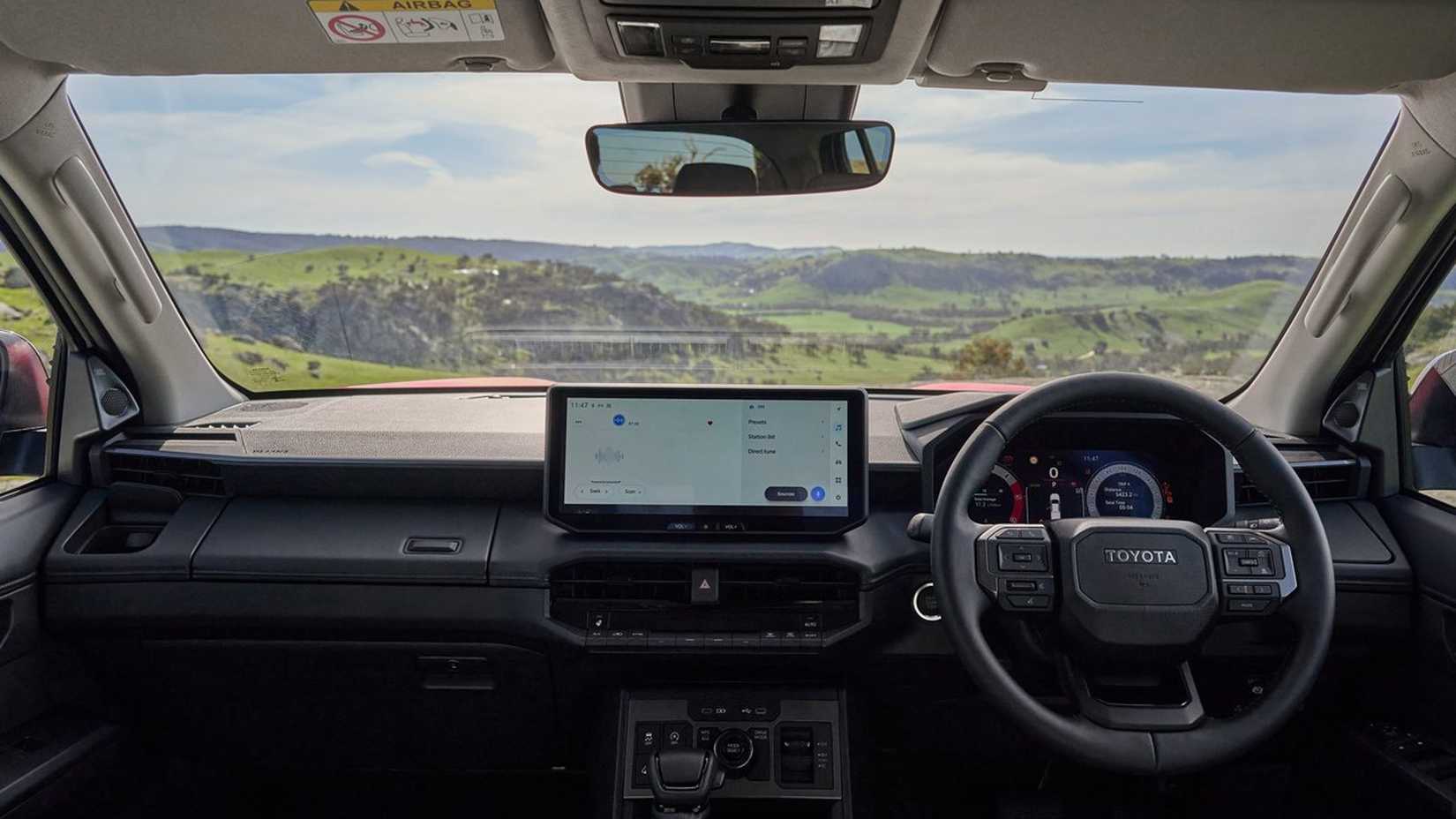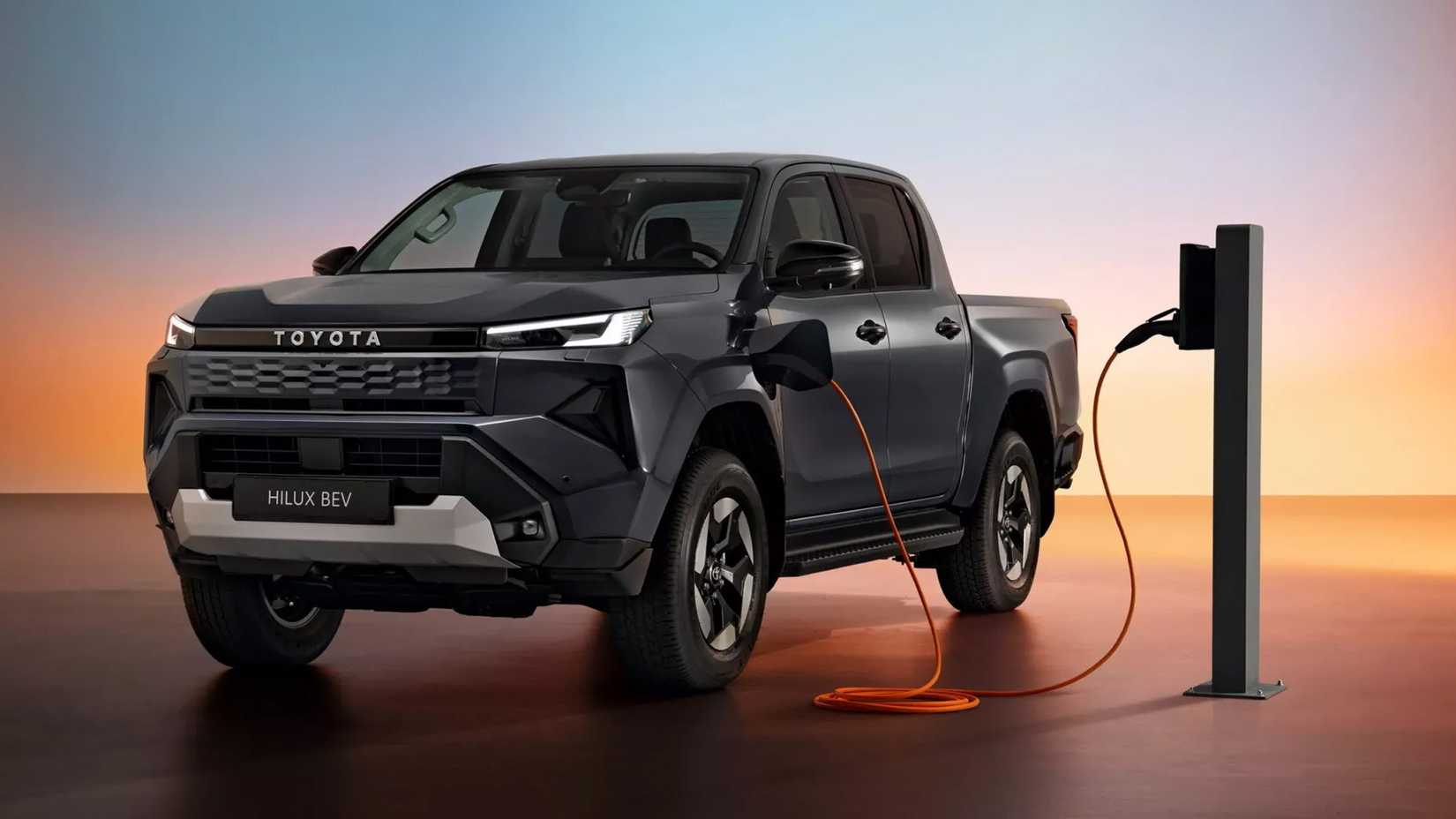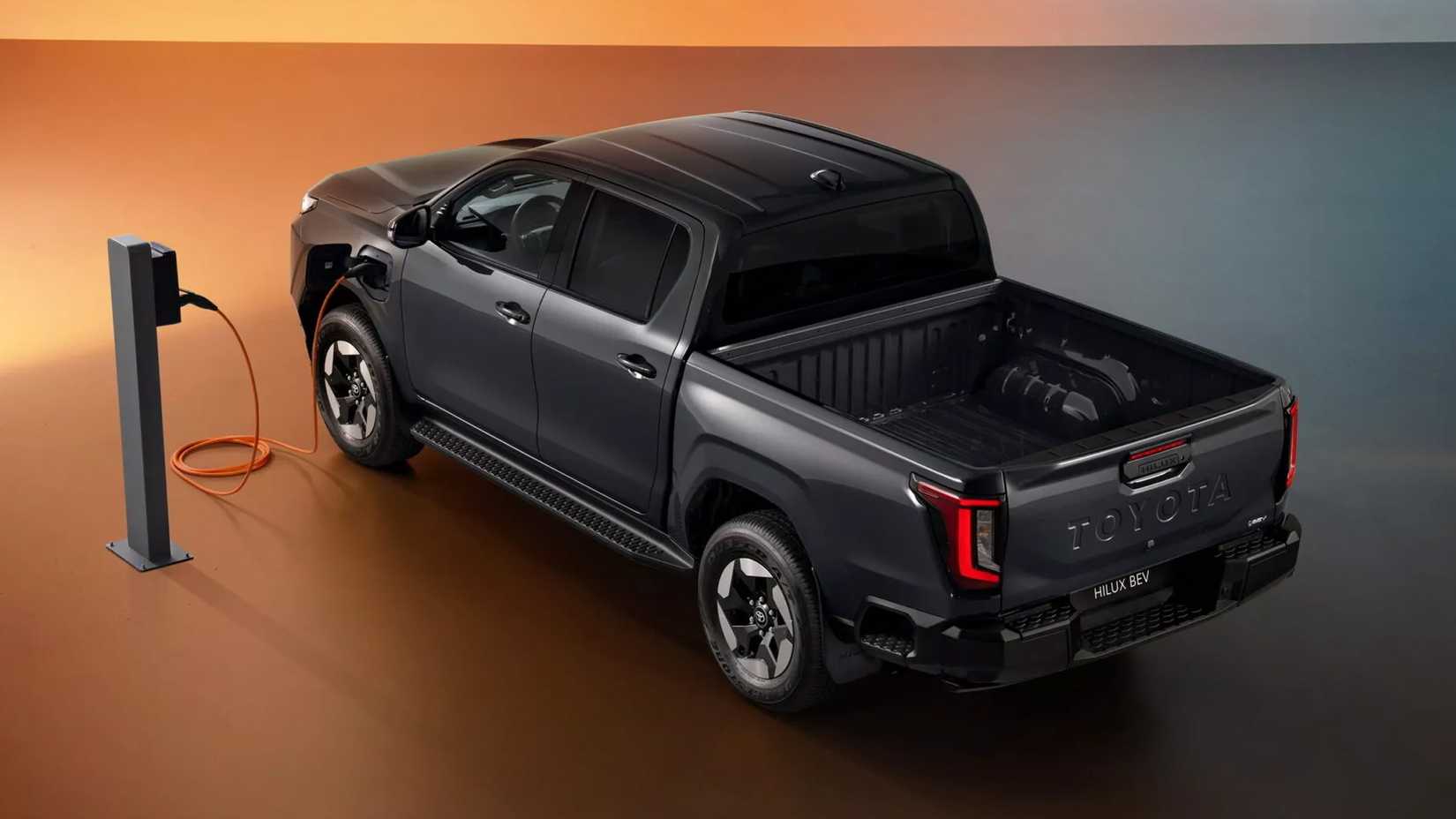Toyota moved more than 600,000 Hilux pickups worldwide in 2024, so it’s no small event when the brand introduces a new generation of its globally beloved midsize truck — the Hilux, which serves as the international counterpart to America’s Tacoma. The ninth-generation Hilux was officially revealed in Thailand, one of the truck’s key development hubs and one of six nations responsible for building the model for both local and export markets.
While the new Hilux isn’t a complete ground-up redesign, it brings a substantial update to the outgoing model. The biggest headline? A broader range of powertrain options, including — for the first time — fully electric and hydrogen fuel cell variants, signaling Toyota’s commitment to blending the Hilux’s legendary toughness with next-generation propulsion tech.
Next Evolution Of IMV

The new Hilux rides on the latest evolution of Toyota’s IMV (Innovative International Multi-purpose Vehicle) platform, first introduced two decades ago with the seventh-generation model. Like the TNGA-F architecture used in Toyota’s North American trucks such as the Tacoma, the IMV platform retains a body-on-frame design built for durability. However, it’s intentionally simpler, tougher, and less modular, reflecting the Hilux’s focus on rugged dependability and global adaptability rather than luxury or refinement.
Among the most notable upgrades to the updated IMV structure are:
-
A new electric power steering system for improved precision and ease of control.
-
Redesigned engine and cabin mounts that cut down on vibration and cabin harshness.
-
Extended front frame rails to enhance crash performance.
-
A revised suspension setup with independent coil springs in the front and a rigid rear axle with leaf springs for strength and load-carrying capability.
Additionally, all 4WD variants now get a rear locking differential as standard, while Toyota’s Multi-Terrain Select system is available to optimize traction across varying off-road surfaces — a welcome upgrade for those who regularly take their Hilux off the beaten path.

Inside, the new Hilux gets a significant technology and comfort boost — especially in the higher grades that often serve as family haulers as much as work trucks. The cabin now features a 12.3-inch digital instrument cluster (or a 7-inch version on lower trims) paired with a 12.3-inch infotainment touchscreen, bringing the interior experience closer to Toyota’s latest SUVs and pickups.
Despite the tech upgrade, Toyota has been careful to retain plenty of physical controls, ensuring the truck remains user-friendly even with gloves on. The steering wheel, borrowed directly from the Land Cruiser, adds a touch of familiarity and quality.
Additional highlights include:
-
Expanded Toyota Safety Sense driver-assist technologies.
-
Support for over-the-air (OTA) updates, keeping software current without dealer visits.
-
A wireless smartphone charger and improved connectivity options.
Altogether, these updates make the new Hilux not just tougher and more capable — but also far more livable and connected for everyday use.
Diverse Powertrains For Diverse Markets

Because the Hilux serves so many global markets — from Australia to Africa to Southeast Asia — Toyota has prioritized powertrain flexibility with this latest generation. Traditional gasoline and diesel engines remain core offerings, ensuring the truck stays dependable in regions where charging or hydrogen infrastructure is limited.
In addition, Toyota is expanding the lineup with several electrified options, including:
-
A 48-volt mild-hybrid system to improve efficiency on existing engines.
-
A fully electric version for urban and low-emission zones.
-
A hydrogen fuel cell variant, part of Toyota’s long-term zero-emission research.
This reflects Toyota’s multi-path strategy — developing multiple technologies simultaneously rather than committing to a single route toward decarbonization.
While no conventional hybrid (HEV) setup was confirmed, Toyota did detail the electric Hilux, which pairs a 59.2-kWh lithium-ion battery with dual motors for all-wheel drive and a combined 193 horsepower. Estimated range is around 150 miles per charge on the WLTP cycle (a bit less under EPA standards), with payload and towing capacities rated at 1,575 lbs and 3,527 lbs, respectively — modest, but solid figures for an early production electric workhorse.

Toyota’s 48-volt mild-hybrid diesel setup will serve as the efficiency-focused backbone of the new Hilux lineup. The system pairs a 2.8-liter turbodiesel inline-four — already familiar from the outgoing model — with a compact 48-volt electric motor-generator and small lithium-ion battery pack.
The diesel engine alone delivers 201 horsepower and 369 lb-ft of torque, while the mild-hybrid unit provides a temporary boost of 16 hp and 48 lb-ft during acceleration or heavy loads. This assists with smoother stop-start operation, stronger low-end torque, and slightly better fuel economy without sacrificing the rugged reliability that Hilux buyers expect.
Payload and towing are expected to remain nearly identical to the outgoing version — around 2,200 pounds and 7,700 pounds, respectively — keeping the truck’s strong workhorse credentials intact.
Toyota has confirmed that deliveries will begin in the first half of 2026, with the hydrogen fuel cell variant arriving later, around 2028, targeting European and Pacific markets where hydrogen infrastructure is growing fastest.
FAQ’s
1. What makes the new Toyota Hilux unique compared to previous models?
The new Hilux stands out by offering multiple powertrain options—diesel, electrified (hybrid or battery-assist), and hydrogen—giving buyers flexibility between traditional fuel, lower-emission electric assist, and zero-tailpipe-emission hydrogen variants while retaining the Hilux’s rugged capability.
2. How does the Toyota Hilux combine diesel, electric, and hydrogen power?
Toyota offers separate versions rather than a single powertrain that uses all three simultaneously: a conventional diesel model, an electrified model that pairs an internal-combustion engine with an electric motor/battery, and a hydrogen-powered model that either uses a hydrogen internal-combustion unit or a fuel cell to generate electric power.
3. Is the hybrid powertrain in the new Hilux self-charging or plug-in?
Most likely the mainstream Hilux hybrid will be a self-charging (full hybrid) system that recovers braking energy and assists the engine, while a plug-in hybrid (PHEV) could be offered in higher trims or specific markets—Toyota tends to deploy both approaches depending on region and demand.
4. How does Toyota’s hydrogen technology work in the Hilux?
Toyota’s hydrogen option could be implemented as either a hydrogen fuel-cell system that converts hydrogen into electricity to drive electric motors, or as a hydrogen internal-combustion engine that combusts hydrogen instead of diesel. Either approach produces much lower tailpipe emissions than diesel.
5. What is the expected fuel efficiency of the new Hilux?
Fuel efficiency varies widely between powertrains: the diesel retains competitive MPG for long-range use, the hybrid improves urban and mixed-cycle efficiency significantly, and the hydrogen fuel-cell model’s efficiency is best measured in miles per kilogram of hydrogen rather than MPG.
6. Can the Hilux switch between diesel, electric, and hydrogen modes automatically?
No single vehicle is likely to house all three systems simultaneously; instead, buyers choose a diesel, hybrid/electric, or hydrogen model. Within hybrid variants, the system will seamlessly switch between electric and engine assist as needed.
7. What kind of battery does the electric system in the Hilux use?
Toyota typically uses lithium-ion batteries for modern hybrids and plug-in hybrids. The exact battery chemistry and capacity depend on whether the model is a self-charging hybrid or a plug-in hybrid.
8. How long does it take to refuel the hydrogen-powered Hilux?
Refueling hydrogen takes only a few minutes—comparable to filling a diesel tank—making it one of the practical advantages of fuel-cell vehicles versus battery electric vehicles that require longer charging times.
9. What is the driving range of the Hilux in hybrid or hydrogen mode?
Range depends on the chosen powertrain: diesel models typically offer the longest range per fill-up; hybrids extend combined fuel economy and range over city driving; hydrogen fuel-cell variants can also provide long ranges comparable to diesel when hydrogen tanks are full.
10. Is the hydrogen fuel system safe in off-road or high-temperature conditions?
Hydrogen storage and delivery systems are engineered to strict safety standards, with robust tanks, pressure relief mechanisms, and protective packaging. Manufacturers design them for real-world conditions, including off-road usage, though operators should still follow safety guidelines.
11. How much horsepower and torque does the new Hilux produce?
Output depends on the powertrain: the diesel will focus on torque for towing and load-carrying, the hybrid balances power and efficiency with an electric torque boost, and hydrogen (especially fuel-cell electric) delivers smooth electric torque characteristics—specific figures vary by market and trim.
12. What is the towing capacity of the new Hilux?
Towing capacity is expected to remain competitive with prior Hilux models, though exact numbers will depend on powertrain, chassis tuning, and market regulations. Diesel versions typically offer robust towing figures, with hybrids and hydrogen variants engineered to meet similar capability targets.
13. Does the Hilux still maintain its rugged off-road capability?
Yes—the Hilux’s reputation for toughness is a core design priority. Toyota engineers adapt the different powertrains to preserve payload, suspension travel, chassis strength, and the Hilux’s off-road geometry and durability.
14. How does the hybrid system affect the truck’s payload capacity?
Hybrid components (battery and electric motor) add weight, which can slightly reduce payload capacity unless Toyota offsets this with structural changes. Toyota will likely specify payload ratings for each powertrain variant so buyers can select the best option for their needs.
15. Does the new Hilux have an all-wheel-drive option?
Yes—traditional Hilux models have offered part-time and full-time four-wheel-drive systems, and Toyota is expected to continue offering AWD/4WD options across diesel, hybrid, and hydrogen variants where market demand exists.
16. How does the new Hilux perform compared to the Ford Ranger or Toyota Tacoma?
Performance comparisons vary by powertrain and market. The Hilux aims to match or exceed competitors in durability, capability, and modern tech. Diesel and hybrid variants may provide better fuel economy versus direct rivals, while hydrogen models offer a unique emissions advantage where infrastructure exists.
17. How eco-friendly is the new Toyota Hilux compared to diesel-only versions?
Hybrids and hydrogen versions offer significantly lower tailpipe emissions—hybrids reduce fuel consumption and CO2, while hydrogen fuel-cell models have zero tailpipe CO2 emissions. Lifecycle emissions depend on hydrogen production methods and electricity sources used to charge batteries.
18. How much lower are the emissions from the hydrogen version?
Hydrogen fuel-cell vehicles have near-zero tailpipe emissions (water vapor is the main byproduct). Total environmental benefit depends on how the hydrogen is produced: green hydrogen (from renewable electricity) delivers the largest emissions reductions compared with hydrogen made from fossil fuels.
19. What role does the new Hilux play in Toyota’s carbon-neutral goals?
The Hilux supports Toyota’s broader strategy by introducing low- and zero-emission options into a mainstream, globally popular pickup platform—accelerating adoption of alternative fuels and electrification in markets where pickups are important.
20. Can hydrogen-powered vehicles really help reduce global emissions?
Yes—especially for heavy-duty and long-range applications where batteries are less practical. The emissions benefit depends on scaling green hydrogen production and building refueling infrastructure; when hydrogen comes from renewable sources, its climate benefits are substantial.
21. Does the new Hilux feature a redesigned exterior or interior?
The latest Hilux generation typically includes updated styling and interior tech to match modern customer expectations—improved infotainment, driver-assistance systems, and updated cabin materials—while keeping practical utility at the forefront.
22. What new technology features come with the Hilux (infotainment, ADAS, etc.)?
Expect modern infotainment with smartphone integration, digital driver displays, advanced driver-assistance systems (lane-keep, adaptive cruise, automatic emergency braking), and vehicle energy-management systems tailored to hybrid and hydrogen variants.
23. Will Toyota offer different trims for the hybrid and hydrogen versions?
Yes—Toyota typically differentiates trims by capability and convenience features, so hybrid and hydrogen models will likely be offered across multiple trim levels or as special variants to appeal to different buyer needs.
24. Are there visual differences between the diesel, electric, and hydrogen models?
Manufacturers often add subtle styling cues to differentiate powertrains—unique badging, grille or bumper designs, aerodynamic touches, and sometimes distinct wheel designs or trim colors that signal hybrid or hydrogen technology.
25. Does the Hilux include any smart energy management systems?
Yes—hybrid and hydrogen variants typically include energy management software that optimizes battery charge, regenerative braking, engine-assist strategies, and in the case of fuel cells, power flow between the stack, battery, and electric motor to maximize efficiency and responsiveness.
26. When will the new Toyota Hilux be released?
Launch timing varies by region and Toyota’s product calendar. Toyota usually announces regional release dates and production schedules ahead of local market launches; check Toyota’s regional press releases or dealer communications for exact dates in your area.
27. Which markets will get the hydrogen-powered Hilux first?
Hydrogen variants will likely debut in regions with early hydrogen infrastructure and policy support—such as parts of Europe, Japan, and specific pilot regions—before wider rollout where refueling networks are limited.
28. What is the estimated price of the new Hilux hybrid or hydrogen model?
Pricing depends on powertrain, trim, and market. Hybrid and hydrogen options typically carry a premium over base diesel models due to advanced components and development costs; official pricing is announced when Toyota releases local configurations.
29. Will Toyota sell the hydrogen Hilux in the United States?
Availability in the U.S. depends on market demand and hydrogen refueling infrastructure. If Toyota sees sufficient demand and infrastructure in targeted states, it may introduce a hydrogen model there—otherwise initial launches may focus on markets with stronger hydrogen support.
30. How does the Hilux fit into Toyota’s future plans for electric trucks and SUVs?
The multi-powertrain Hilux demonstrates Toyota’s flexible approach to decarbonization—offering conventional, hybrid, and hydrogen options as stepping stones toward broader electrification—while Toyota continues investing in battery-electric platforms and fuel-cell technology across its commercial and passenger vehicle lineup.
Related posts:
- History Of The Dodge Logo: More Than A Century Of Change
- Another Automaker Bailed On Apple CarPlay Ultra
- The First Lamborghini Temerario Ad Personam Build Is Tastefully Understated
- This Is How Fast The Corvette ZR1 Is Around The Nürburgring
- New Chinese Off-Roader Looks Like A Cross Between A Land Cruiser And Defender
- Dodge ‘New Muscle’ Teaser Has Hemi Written All Over It
- Dodge Finally Gives Buyers The Gas Charger They Almost Wanted From $50,000
- Two New Porsche 911 Variants Just Arrived To Dominate Your Local Racetrack
- 2026 Infiniti QX80 Gets Stealthy and More Expensive
- Toyota Is So Obsessed With Hydrogen It’s Fixing Problems That Don’t Exist
